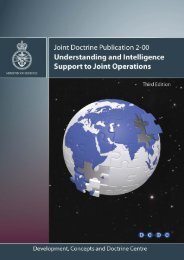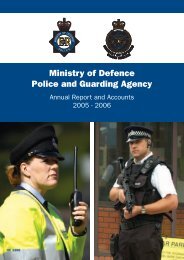JSP 464 - Ministry of Defence
JSP 464 - Ministry of Defence
JSP 464 - Ministry of Defence
Create successful ePaper yourself
Turn your PDF publications into a flip-book with our unique Google optimized e-Paper software.
Home Owners<br />
12. Funding the provision <strong>of</strong> adaptations to the private homes <strong>of</strong> injured Service<br />
Personnel who are retained by the Armed Forces is a TLB responsibility, until their last day<br />
<strong>of</strong> service, after which responsibility transfers to the appropriate NHS Primary Care Trust.<br />
Adaptations to a parental home, where this is the primary <strong>of</strong>f-duty residence <strong>of</strong> the injured<br />
Service person, are included in this policy as are adaptations to a second property when<br />
an injured Service person moves from an adapted parental home into their own property<br />
(again, until their last day <strong>of</strong> Service). 2 Where injured personnel are occupying substitute<br />
accommodation, guidance is to be sought from the appropriate single Service Housing<br />
Colonel. 3<br />
Reservists<br />
13. Mobilised Reserves and FTRS(FC). Reserve Forces personnel are eligible for a full<br />
range <strong>of</strong> DMS 4 healthcare on the same basis as regulars when they are mobilised or<br />
serving on FTRS(FC). DMS is responsible for medical care and OT assessment costs<br />
where the mobilised reservist has sustained a serious injury or disability, with the relevant<br />
TLB responsible for adaptations including fitting until termination <strong>of</strong> service, or when a<br />
medical discharge date is <strong>of</strong>fered. Following a period <strong>of</strong> mobilised service the reservist will<br />
transfer back to NHS care. The accommodation adaption policy for seriously injured<br />
FTRS(FC) personnel is the same as for regular personnel.<br />
14. Medical Employment Standards 5 determine that a Reservist can be maintained in a<br />
downgraded category for a fixed period <strong>of</strong> at least six months to eighteen months<br />
continuously before requiring referral to a Medical Board. Until a medical discharge date is<br />
<strong>of</strong>fered, PCTs are dissolved <strong>of</strong> responsibility for funding/provision <strong>of</strong> adaptations in<br />
Reservists’ own homes as it remains the responsibility <strong>of</strong> the relevant TLB.<br />
15. Sponsored Reserves. Sponsored Reserves (SRs) are not entitled to occupy SFA or<br />
SLA. When mobilised, the responsibilities for SR medical care will transfer from the NHS<br />
to the DMS. DMS is responsible for the medical care and OT assessment costs if the<br />
mobilised SR sustained a serious injury or disability, with the relevant TLB responsible for<br />
adaptations, including fitting, until demobilisation. Medical care and treatment will transfer<br />
back to the NHS upon demobilisation when costs, identification and fitting <strong>of</strong> adaptations<br />
will then fall to the relevant PCT.<br />
16. . Non-Mobilised Volunteer Reserves. All non-mobilised Reservists injured whilst on<br />
duty are eligible for emergency treatment from DMS but within the current structure <strong>of</strong> both<br />
the DMS and the NHS. The majority <strong>of</strong> reservists who sustain an injury while on duty and<br />
require further treatment following emergency treatment will transfer to NHS care. For all<br />
non-mobilised reservists the responsibility for primary health care rests with the NHS,<br />
however, those that sustain a significant injury whilst on duty can be considered for<br />
treatment within DMS facilities if suitable facilities are not available in the NHS following<br />
2 Adaptations resulting from operational injuries are an allowable cost against the Reserve under Net Additional Cost <strong>of</strong> Military<br />
Operations (NACMO). The funding is for the duration <strong>of</strong> the Service person’s recovery pathway and limited to a maximum <strong>of</strong> 2<br />
moves/addresses, up to 3 years after the SP’s Return to Unit and only for the period during which Operational costs are authorised to<br />
be drawn from the Reserve. Once a decision has been made to retain a Service person, the respective TLB will become responsible for<br />
the adaptations from that point onwards and for providing adaptations for any subsequent accommodation. At the stage that an<br />
Operation ceases to qualify for Reserve funding, the liability for funding adaptations will revert to TLBs.<br />
3 Service Housing Colonels should refer to DCDS Pers SCW for guidance in this area.<br />
4 <strong>JSP</strong> 751 – Joint Casualty and Compassionate Policy and Procedures Issue 5 dated Sept 07.<br />
5 <strong>JSP</strong> 346- PULHHEEMS- Joint System <strong>of</strong> Medical Classification<br />
As at 13 Jul 12 3F - 3


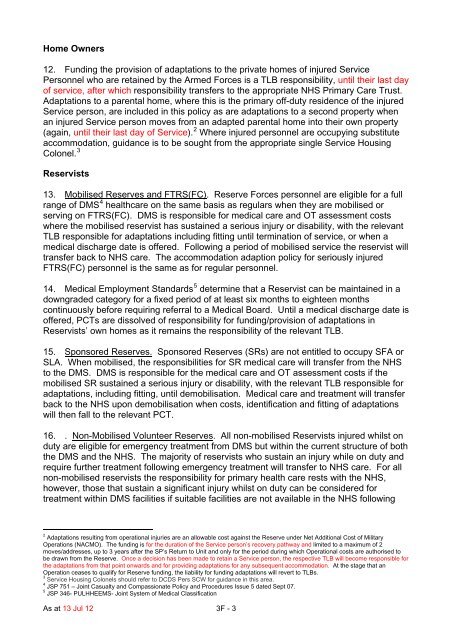
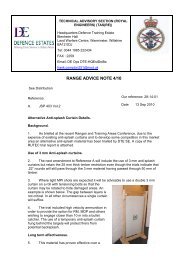

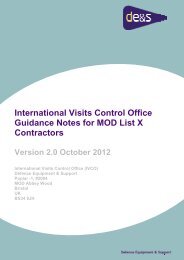

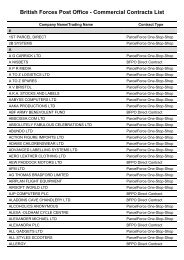

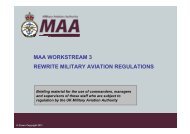

![MAA Regulatory Publications - FAQs PDF [37.3 KB]](https://img.yumpu.com/5906104/1/184x260/maa-regulatory-publications-faqs-pdf-373-kb.jpg?quality=85)
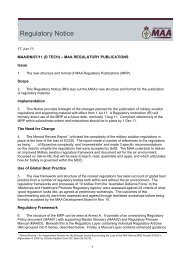
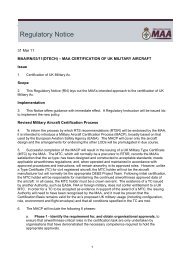
![3750 edition 6 PDF [263.5 KB] - Ministry of Defence](https://img.yumpu.com/5901071/1/184x260/3750-edition-6-pdf-2635-kb-ministry-of-defence.jpg?quality=85)
